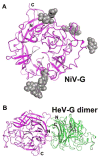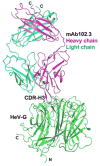Ephrin-B2 and ephrin-B3 as functional henipavirus receptors
- PMID: 22227101
- PMCID: PMC3327611
- DOI: 10.1016/j.semcdb.2011.12.005
Ephrin-B2 and ephrin-B3 as functional henipavirus receptors
Abstract
Members of the ephrin cell-surface protein family interact with the Eph receptors, the largest family of receptor tyrosine kinases, mediating bi-directional signaling during tumorogenesis and various developmental events. Surprisingly, ephrin-B2 and -B3 were recently identified as entry receptors for henipaviruses, emerging zoonotic paramyxoviruses responsible for repeated outbreaks in humans and animals in Australia, Southeast Asia, India and Bangladesh. Nipah virus (NiV) and Hendra virus (HeV) are the only two identified members in the henipavirus genus. While the initial human infection cases came from contact with infected pigs (NiV) or horses (HeV), in the more recent outbreaks of NiV both food-borne and human-to-human transmission were reported. These characteristics, together with high mortality and morbidity rates and lack of effective anti-viral therapies, make the henipaviruses a potential biological-agent threat. Viral entry is an important target for the development of anti-viral drugs. The entry of henipavirus is initiated by the attachment of the viral G envelope glycoprotein to the host cell receptors ephrin-B2 and/or -B3, followed by activation of the F fusion protein, which triggers fusion between the viral envelop and the host membrane. We review recent progress in the study of henipavirus entry, particularly the identification of ephrins as their entry receptors, and the structural characterization of the ephrin/Henipa-G interactions.
Copyright © 2012 Elsevier Ltd. All rights reserved.
Figures





Similar articles
-
Structural and functional analyses reveal promiscuous and species specific use of ephrin receptors by Cedar virus.Proc Natl Acad Sci U S A. 2019 Oct 8;116(41):20707-20715. doi: 10.1073/pnas.1911773116. Epub 2019 Sep 23. Proc Natl Acad Sci U S A. 2019. PMID: 31548390 Free PMC article.
-
Inhibition of henipavirus infection by Nipah virus attachment glycoprotein occurs without cell-surface downregulation of ephrin-B2 or ephrin-B3.J Gen Virol. 2007 Feb;88(Pt 2):582-591. doi: 10.1099/vir.0.82427-0. J Gen Virol. 2007. PMID: 17251577
-
Functional studies of host-specific ephrin-B ligands as Henipavirus receptors.Virology. 2008 Mar 15;372(2):357-71. doi: 10.1016/j.virol.2007.11.011. Epub 2007 Dec 4. Virology. 2008. PMID: 18054977
-
Henipavirus membrane fusion and viral entry.Curr Top Microbiol Immunol. 2012;359:79-94. doi: 10.1007/82_2012_200. Curr Top Microbiol Immunol. 2012. PMID: 22427111 Review.
-
Henipavirus receptor usage and tropism.Curr Top Microbiol Immunol. 2012;359:59-78. doi: 10.1007/82_2012_222. Curr Top Microbiol Immunol. 2012. PMID: 22695915 Free PMC article. Review.
Cited by
-
Emergence and adaptive evolution of Nipah virus.Transbound Emerg Dis. 2020 Jan;67(1):121-132. doi: 10.1111/tbed.13330. Epub 2019 Sep 10. Transbound Emerg Dis. 2020. PMID: 31408582 Free PMC article.
-
Eph receptors and ephrins: therapeutic opportunities.Annu Rev Pharmacol Toxicol. 2015;55:465-87. doi: 10.1146/annurev-pharmtox-011112-140226. Epub 2014 Oct 3. Annu Rev Pharmacol Toxicol. 2015. PMID: 25292427 Free PMC article. Review.
-
Rhabdovirus-based vaccine platforms against henipaviruses.J Virol. 2015 Jan;89(1):144-54. doi: 10.1128/JVI.02308-14. Epub 2014 Oct 15. J Virol. 2015. PMID: 25320306 Free PMC article.
-
Pandemic potential of the Nipah virus and public health strategies adopted during outbreaks: Lessons from Kerala, India.PLOS Glob Public Health. 2024 Dec 19;4(12):e0003926. doi: 10.1371/journal.pgph.0003926. eCollection 2024. PLOS Glob Public Health. 2024. PMID: 39700307 Free PMC article. Review.
-
Nipah virus: a potential pandemic agent in the context of the current severe acute respiratory syndrome coronavirus 2 pandemic.New Microbes New Infect. 2021 May;41:100873. doi: 10.1016/j.nmni.2021.100873. Epub 2021 Mar 19. New Microbes New Infect. 2021. PMID: 33758670 Free PMC article. Review.
References
-
- Chua KB, Bellini WJ, Rota PA, Harcourt BH, Tamin A, Lam SK, et al. Nipah virus: a recently emergent deadly paramyxovirus. Science. 2000;288:1432–5. - PubMed
-
- Negrete OA, Levroney EL, Aguilar HC, Bertolotti-Ciarlet A, Nazarian R, Tajyar S, et al. EphrinB2 is the entry receptor for Nipah virus, an emergent deadly paramyxovirus. Nature. 2005;436:401–5. - PubMed
-
- Selvey LA, Wells RM, McCormack JG, Ansford AJ, Murray K, Rogers RJ, et al. Infection of humans and horses by a newly described morbillivirus. Med J Aust. 1995;162:642–5. - PubMed
Publication types
MeSH terms
Substances
Grants and funding
LinkOut - more resources
Full Text Sources
Miscellaneous

